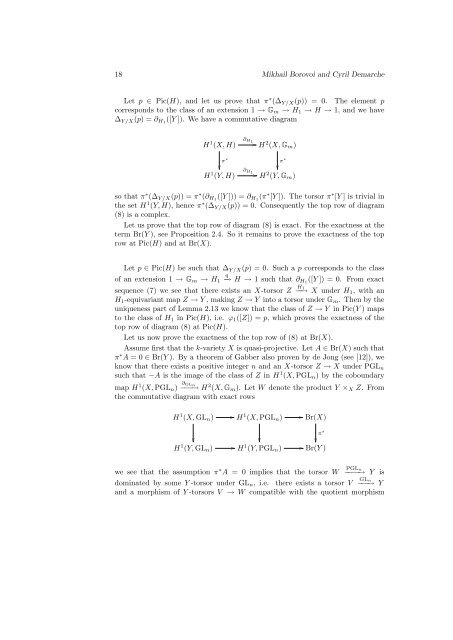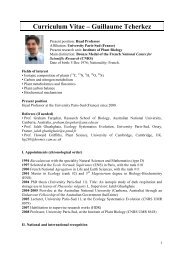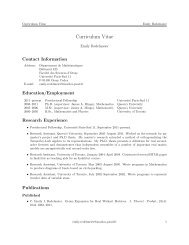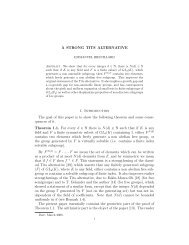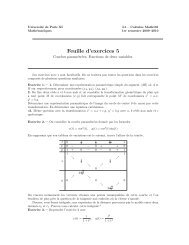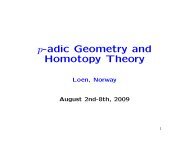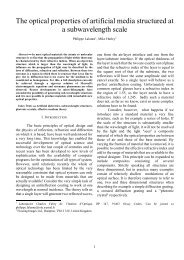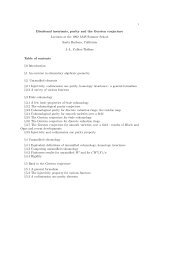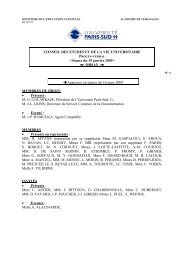Manin obstruction to strong approximation for homogeneous spaces
Manin obstruction to strong approximation for homogeneous spaces
Manin obstruction to strong approximation for homogeneous spaces
You also want an ePaper? Increase the reach of your titles
YUMPU automatically turns print PDFs into web optimized ePapers that Google loves.
18 Mikhail Borovoi and Cyril DemarcheLet p ∈ Pic(H), and let us prove that π ∗ (∆ Y/X (p)) = 0. The element pcorresponds <<strong>strong</strong>>to</<strong>strong</strong>> the class of an extension 1 → G m → H 1 → H → 1, and we have∆ Y/X (p) = ∂ H1 ([Y ]). We have a commutative diagramH 1 (X, H)∂ H1H 2 (X, G m )π ∗H 1 (Y, H)π ∗∂ H1 H 2 (Y, G m )so that π ∗ (∆ Y/X (p)) = π ∗ (∂ H1 ([Y ])) = ∂ H1 (π ∗ [Y ]). The <<strong>strong</strong>>to</<strong>strong</strong>>rsor π ∗ [Y ] is trivial inthe set H 1 (Y, H), hence π ∗ (∆ Y/X (p)) = 0. Consequently the <<strong>strong</strong>>to</<strong>strong</strong>>p row of diagram(8) is a complex.Let us prove that the <<strong>strong</strong>>to</<strong>strong</strong>>p row of diagram (8) is exact. For the exactness at theterm Br(Y ), see Proposition 2.4. So it remains <<strong>strong</strong>>to</<strong>strong</strong>> prove the exactness of the <<strong>strong</strong>>to</<strong>strong</strong>>prow at Pic(H) and at Br(X).Let p ∈ Pic(H) be such that ∆ Y/X (p) = 0. Such a p corresponds <<strong>strong</strong>>to</<strong>strong</strong>> the classqof an extension 1 → G m → H 1 −→ H → 1 such that ∂H1 ([Y ]) = 0. From exactsequence (7) we see that there exists an X-<<strong>strong</strong>>to</<strong>strong</strong>>rsor Z −−→ H1X under H 1 , with anH 1 -equivariant map Z → Y , making Z → Y in<<strong>strong</strong>>to</<strong>strong</strong>> a <<strong>strong</strong>>to</<strong>strong</strong>>rsor under G m . Then by theuniqueness part of Lemma 2.13 we know that the class of Z → Y in Pic(Y ) maps<<strong>strong</strong>>to</<strong>strong</strong>> the class of H 1 in Pic(H), i.e. ϕ 1 ([Z]) = p, which proves the exactness of the<<strong>strong</strong>>to</<strong>strong</strong>>p row of diagram (8) at Pic(H).Let us now prove the exactness of the <<strong>strong</strong>>to</<strong>strong</strong>>p row of (8) at Br(X).Assume first that the k-variety X is quasi-projective. Let A ∈ Br(X) such thatπ ∗ A = 0 ∈ Br(Y ). By a theorem of Gabber also proven by de Jong (see [12]), weknow that there exists a positive integer n and an X-<<strong>strong</strong>>to</<strong>strong</strong>>rsor Z → X under PGL nsuch that −A is the image of the class of Z in H 1 (X, PGL n ) by the coboundarymap H 1 (X, PGL n ) ∂GLn−−−→ H 2 (X, G m ). Let W denote the product Y × X Z. Fromthe commutative diagram with exact rowsH 1 (X, GL n ) H 1 (X, PGL n ) Br(X)H 1 (Y, GL n ) H 1 (Y, PGL n ) Br(Y )π ∗we see that the assumption π ∗ A = 0 implies that the <<strong>strong</strong>>to</<strong>strong</strong>>rsor W −−−−→ PGLnY isdominated by some Y -<<strong>strong</strong>>to</<strong>strong</strong>>rsor under GL n , i.e. there exists a <<strong>strong</strong>>to</<strong>strong</strong>>rsor V −−−→ GLnYand a morphism of Y -<<strong>strong</strong>>to</<strong>strong</strong>>rsors V → W compatible with the quotient morphism


